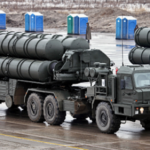Since 2014, the United States has sanctioned multiple Russian companies and individuals for Moscow’s involvement in Ukraine and Syria and allegations it meddled in the U.S. elections. With the latest U.S. round of sanctions, imposed on 6 April 2018 and targeting 400 companies and individuals, almost all of Russia’s leading defence companies are now covered.
Table 1: Leading Russian defence companies sanctioned by the U.S.

The sanctions prevent American companies and individuals from doing business with these entities. This also includes the use of the U.S. banking system to support such business. That is where the real bite of the sanctions lies. For practical reasons, large international transactions such as those involving India’s weapons-purchases from Russia must be done in dollars, and it is not possible to conduct a dollar denominated transaction without accessing the U.S. banking system. Since the sanctions prevent Russian arms suppliers from using U.S. banks, buying arms from them or collaborating with them to develop new systems will be difficult.
The impact of this barrier to continued procurement with Russia could be substantial. India, which is the world’s largest importer of arms, is a leading buyer of Russian military hardware. Between 2012 and 2017, India imported $22.4 billion worth of weapons, of which 67% was from Russia. An as yet undetermined amount of this trade is now in question. A proposed $4.5 billion deal to acquire the S-400 anti-missile system from Russia may be a harbinger. The transaction was announced in October 2016[1] and was expected to be consummated by now, but it has been stuck for some time – possibly due to sanctions[2].
Interruption of arms procurement from Russia will be disruptive and hard to offset. Most of India’s advanced weapons systems – the Sukhoi-30 and MiG-29 jets, T-90 tanks and several naval ships and submarines — are of Russian origin. Russia has been a reliable supplier of high-tech weaponry since the 1960s. Only the U.S. offers a similar portfolio, but at much higher prices and with many restrictions and strings attached.
U.S. sanctions also could cause problems for India’s attempts to indigenise its defence production. The Indian government has proposed a ‘Strategic Partnership Model’, which envisages long-term partnerships of Indian vendors with foreign technology providers[3]. To encourage these partnerships, the Revised Defence Procurement Policy 2016 gives preferential treatment to equipment with higher indigenous content[4].
In anticipation, leading Indian companies such as L&T[5], the Tata Group[6], Mahindra[7] [8] and Bharat Forge[9] have formed partnerships with foreign military vendors to tap this market. So far however, most of these partnerships have been with western defence suppliers. Of the 69 such joint ventures studied by Gateway House, just four have been signed with Russian partners[10] — and three of them are with public sector entities. Just one Indian private sector firm has a defence joint venture with a Russian partner.
Most of India’s leading corporate houses have significant business interests in the U.S. and rely on international markets for finance. Dealing with sanctions-hit Russian entities is too big a risk for them.
Table 2: Joint Venture between Indian and Russian defence entities

With virtually all the top Russian companies under sanctions, the Indian private sector will be even more reluctant to enter into such partnerships in the future. It will play a larger role in defence manufacturing in the future. For instance, L&T has had a part in manufacturing India’s first nuclear submarines and Reliance Naval Shipyard is building vessels for the Indian coastguard[11]. The sanctions mean these companies will not seek Russian partners.
In the short run, India can and must seek waivers to U.S. sanctions for defence deals with Russia. However, U.S. sanctions are unlikely to go away in a hurry, and waivers may not be forthcoming since the U.S. may see a business opportunity for its own vendors in disrupting Russian weapons-supply relationships. So India needs to find ways to work around the sanctions. One possibility might be to use state-owned firms, which don’t have any business ties in the West and are therefore less vulnerable to the threat of sanctions, to partner with Russian firms in critical areas. India needs to explore the ramifications of this and other options.
Amit Bhandari is Fellow, Energy and Environment Studies, Gateway House.
Kunal Kulkarni is Senior Researcher at Gateway House.
This blog was exclusively written for Gateway House: Indian Council on Global Relations. You can read more exclusive features here.
For interview requests with the author, or for permission to republish, please contact outreach@gatewayhouse.in or 022 22023371.
© Copyright 2018 Gateway House: Indian Council on Global Relations. All rights reserved. Any unauthorized copying or reproduction is strictly prohibited.
References
[1] Ministry of External Affairs, Government of India, List of agreements/MOUs exchanged during India-Russia Annual Summit (October 15, 2106, 15 October 2016, <http://mea.gov.in/bilateral-documents.htm?dtl/27481/List_of_agreementsMOUs_exchanged_during_IndiaRussia_Annual_Summit_October_15_2016>
[2] ‘India-Russia set to seal S-400 Triumf missile deal despite threat of US sanctions’, Zee News, 6 April 2018, <http://zeenews.india.com/india/india-russia-set-to-seal-s-400-triumf-missile-deal-despite-threat-of-us-sanctions-2097136.html>
[3] Ministry of Defense, Government of India, Unstarred Questions No. 4363, 21 March 2018, <http://164.100.47.190/loksabhaquestions/annex/14/AU4363.pdf>
[4] Ministry of Defense, Government of India, Unstarred Questions No. 6144, 4 April 2018, <http://164.100.47.190/loksabhaquestions/annex/14/AU6144.pdf>
[5] Larsen & Toubro, Larsen & Toubro and MBDA establish Joint Venture for development of sophisticated missile systems, 13 February 2017, <http://www.larsentoubro.com/media/34396/2017-02-13-larsen-toubro-and-mbda-establish-joint-venture.pdf>
[6] Tata Advanced Systems, Joint Ventures and Subsidies, <http://www.tataadvancedsystems.com/static.php?id=34>
[7] Mahindra & Mahindra, Mahindra-BAE Systems sign Joint Venture agreement, <http://www.mahindra.com/news-room/press-release/1293780245>
[8] Boeing, Boeing Partners with HAL and Mahindra for F/A-18 Super Hornet ‘Make in India’, 12 April 2018, <http://www.boeing.co.in/news-and-media-room/news-releases/2018/april/boeing-partners-with-hal-and-mahindra-for-fa-18-super-hornet-make-in-india.page>
[9] Bharat Forge, Bharat Forge and Elbit Systems Establish a JVC for Artillery Systems in India, 7 February 2013, <http://bharatforge.com/german/images/PDFs/press-release/2013/Bharat_Forge_Elbit_JVC.pdf>
[10] Gateway House: Indian Council on Global Relations, The business of defence: role of India’s private sector, 12 May 2015, <https://www.gatewayhouse.in/wp-content/uploads/2015/05/Sameer-Patil_Policy-Perspective_May12.pdf>
[11] Reliance, Clarification on news flashed on CNBC TV 18 on September 21, 2016 stating that “Reliance Defence wins bid to build 14 Fast Patrol Vessels”, 22 September 2016, <http://www.rnaval.co.in/documents/1365184/1372035/14_FPV.pdf/b917be6d-3be2-4cbf-d2d4-535437feb534>


